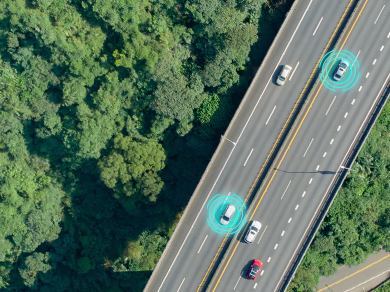Your daily commute may not start with “Beam me up!” but you know it’s getting increasingly high tech. And the technology both inside and outside cars is improving the safety of drivers, as well as pedestrians, cyclists, and others.
Since 2018, all cars in the US have required backup cameras to prevent rear-moving collisions. Blind-spot monitoring systems have also become common. They typically use sensors to alert drivers when another vehicle has entered their blind spot, preventing lane-change accidents. Some of those sensors can take quick control themselves, automatically steering the car away from danger.
More improvements are still in the future. The nation’s recent behemoth infrastructure bill has required numerous improvements in car technology, some of which already exist, such as automatic emergency braking, as well as forward-collision, lane-departure, rear cross-traffic, and blind-spot warnings. Other aspects are still to be developed, including technology that limits drunk driving, perhaps by recognizing abnormal driving behavior or testing a driver’s breath.
One of the biggest developments has been assisted driving, which in just a few years has rocketed from science fiction to commonplace. Many modern cars go beyond chimes or beeps that warn of danger: they actually take over wheel and brake functions to avoid an accident. Adaptive cruise control lets a vehicle adjust speed on its own to keep its distance from other cars on the road. No automaker markets a completely autonomous car yet, but that could be in the future.
As car technology changes, roadways must also change to keep driving safe. “Because of recent construction, I have to fight with my car’s technology in certain merge points on my way to work,” says John Tyler, P.E., Vice President at Pape-Dawson Engineers His car’s assisted driving features identify old lane markings, even when they’re painted black, and ignores the temporary lane designations.
“It’s easy and cheap to use a milling machine to grind off old pavement markings,” John explains, “but it just doesn’t work for newer cars, so we have to adapt to that.” Grinding off the surface paint and adding new lines is just fine for human eyes. Unfortunately, that process can cause accidents for cars with new safety features. Raised pavement markers (which are more expensive and prone to chip) can direct both human and automated drivers the right way. Microsurfacing or other one-course surface treatments can also prepare a roadway for new paint that both humans and car sensors can identify.
As cars take over an increasing amount of the driving task, roads will begin to change, since the assumptions traffic engineers like John use to design them will change. “A typical driver takes 2.5 seconds to identify, decide, and react when there’s a new stimulus,” he says. “If you’re going 60 miles per hour, you’ll travel three-quarters of a football field in that time.” When cars become fully autonomous, reaction time will be cut substantially, which will change the design of traffic features, and perhaps even the roads themselves.
With increasing use of assistive driving and GPS-guided navigation, the need for directional signs will diminish, and roads will have fewer of them. “It’s not happening immediately, but it’s not too far in the future for us to start thinking about it now,” says John. He predicts some of those changes are coming in the next decade. Others are farther out: “When all cars are self-driving, they’ll be tailgating each other—safely—and that will change the look of the roads.” John predicts speedier, narrower travel lanes with smaller space cushions around each car. Precise sensors will monitor conditions and make minute adjustments in a fraction of the time a human would take. “We may not see a full retrofit to those new lanes,” he adds, “but I can imagine full-autonomous-drive lanes springing up, sort of like the HOV [high-occupancy vehicle] lanes we have now.”
When that happens, John says, you can expect traffic signals to become antiques, since remotely linked vehicles won’t depend on a light to tell them when to safely proceed. Long before then, though, you will likely see a subtle change to local stoplights—crosswalk buttons will disappear. No need for alarm, though, since motion sensors will detect cyclists and pedestrians to change signal timing.
Some traffic innovations are here today. Others seem like something out of a sci-fi movie. But remember: the iPhone first arrived 15 years ago and is now one of the most popular phones available on the market. Right now, automakers and traffic engineers are working on technology that will change the way you drive—or the way your car drives YOU—15 years from now, on roads that may look a lot different than today’s.
